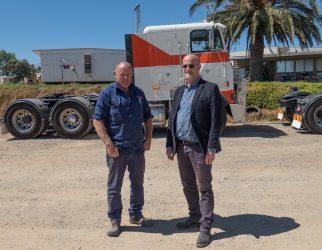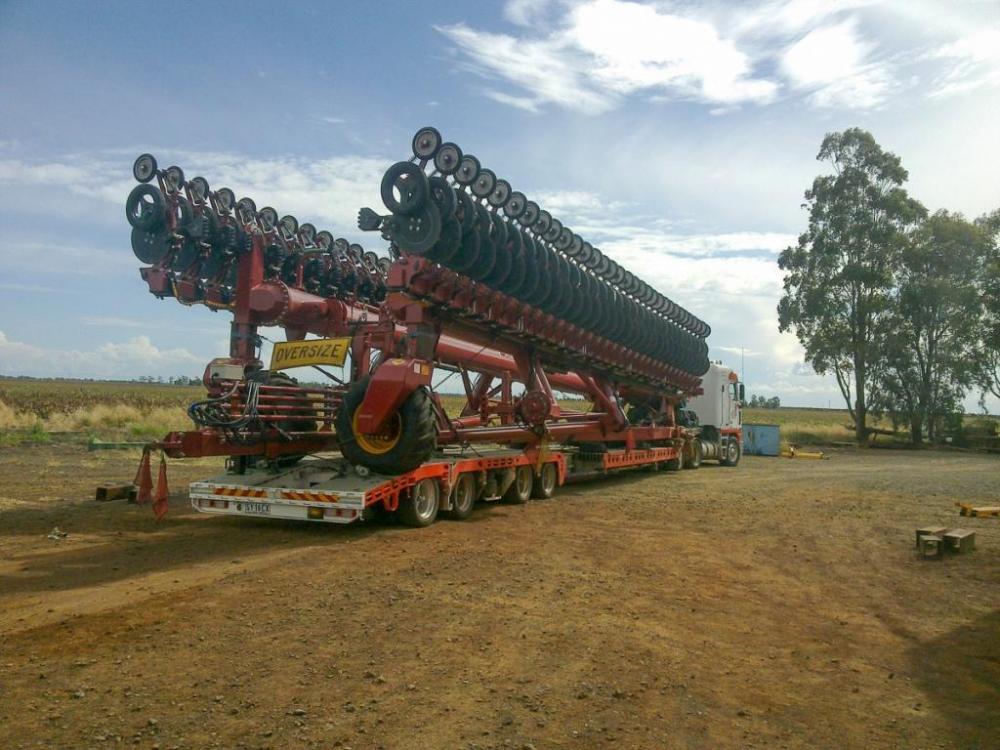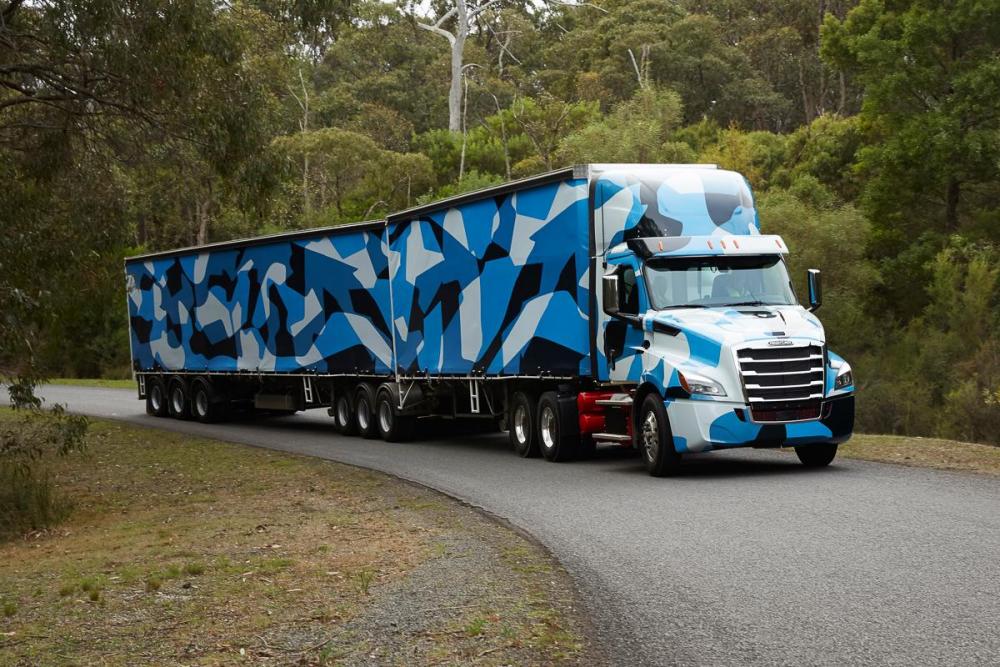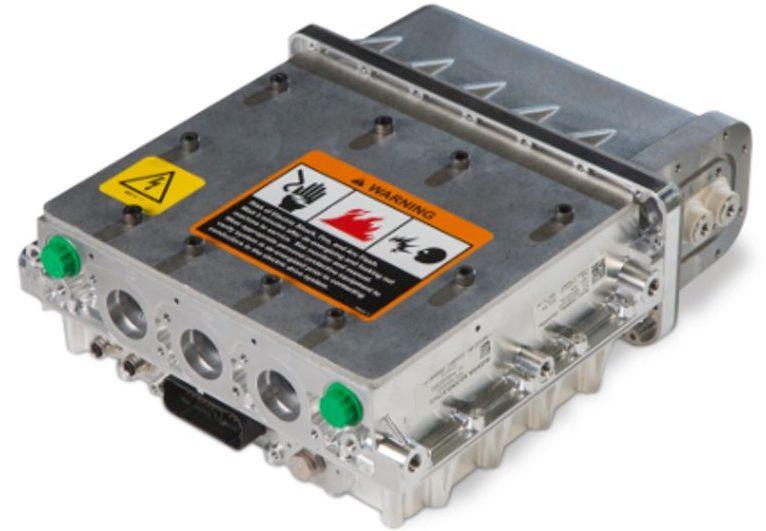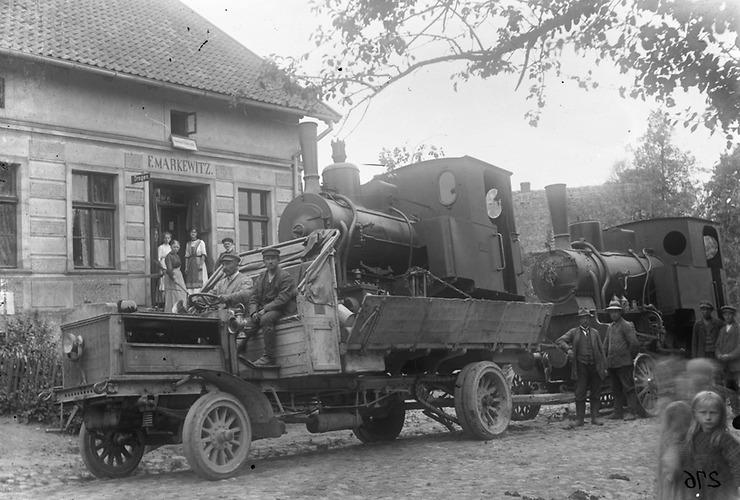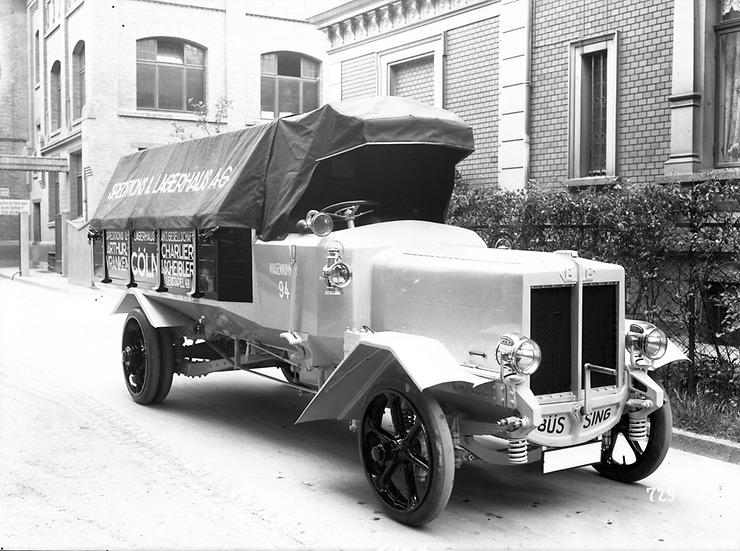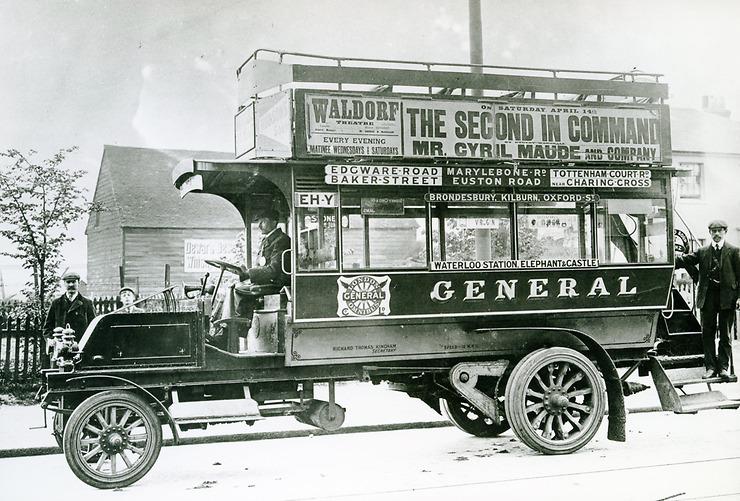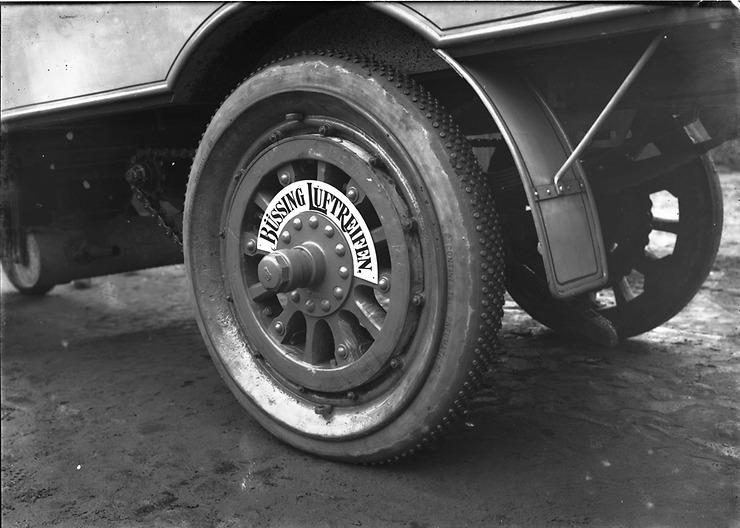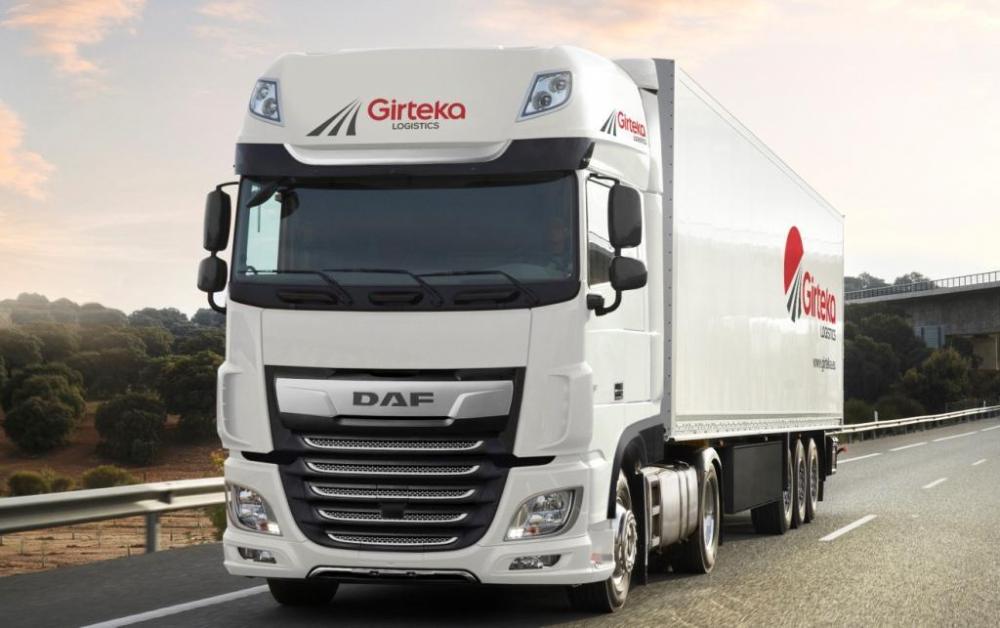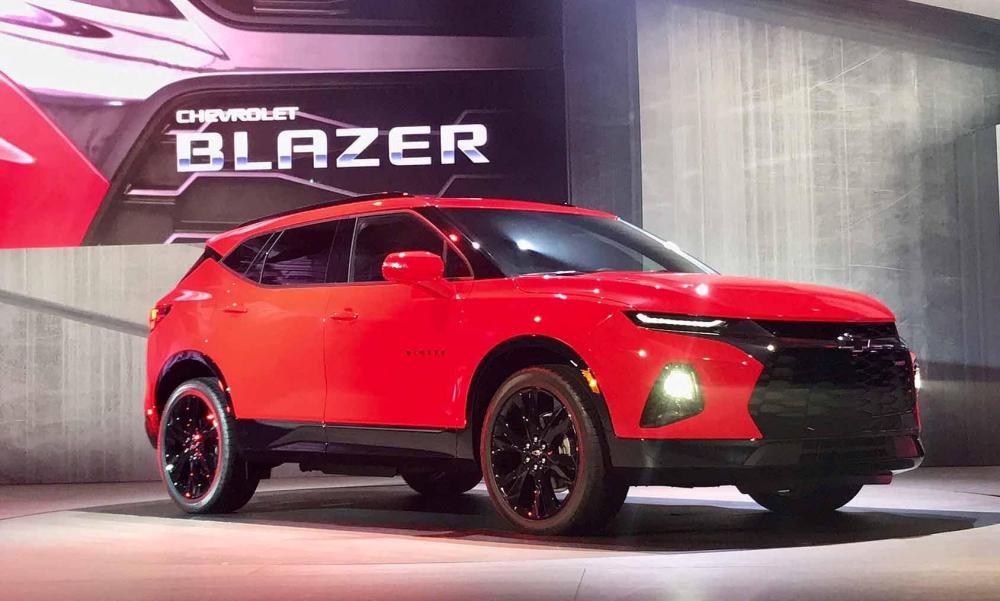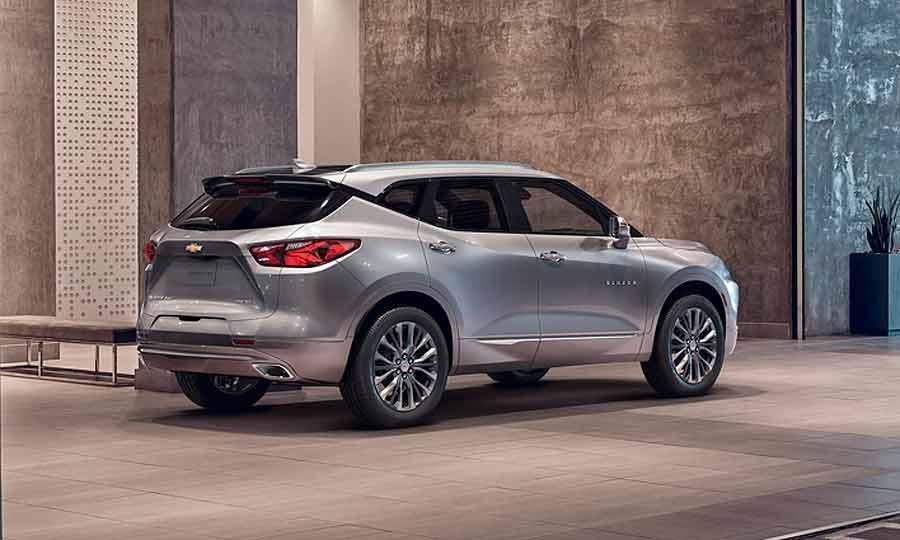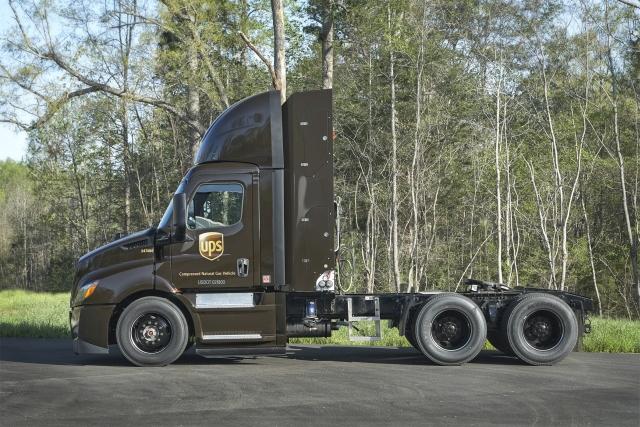
kscarbel2
Moderator-
Posts
18,855 -
Joined
-
Days Won
114
Content Type
Profiles
Forums
Gallery
Events
Blogs
BMT Wiki
Collections
Store
Everything posted by kscarbel2
-
Diesel News Australia / June 2018 A South Australian heavy haulage outfit is planning the return of the Freightliner FLB. Ken Pitt, All Size Equipment Transport (ASET) Managing Director has moved away from a policy of buying new trucks as he says he hasn’t found a specification available in a new truck that can match what he can achieve in terms of configuration and mass. ASET are buying old Freightliner FLB trucks and rebuilding them to suit the tasks they are undertaking. According to Ken, the FLB has a number of advantages as a platform on which to build. It has a front axle set well forward, giving any combination good axle spread, helping the loads stay inside the restrictive oversize over-mass envelope. The tare weight of a finished FLB can be around seven tonnes, whereas a brand new equivalent, like a Freightliner Argosy or Kenworth K200 will come in around 10 tonnes. This three tonnes, again, helps ASET keep loads within the envelope. “We can get the FLBs down below 7 tonnes tare, and they are still a 70 to 90 tonne GCM truck,” says Ken. ASET have found a sweet spot where their combination will be able to handle a load on a normal semi, but many of their competitors will have to use a converter dolly to spread the weight from the front of the trailer. However, Ken does admit to the necessity of bringing some new trucks into the fleet and is looking at the Argosy as the best alternative, with its dimensions more suited to the precise needs of the operation. Argosy models have been customised on arrival at the ASET yard. The suspensions are taken off and rearranged to suit the lower profile tyres the company fits on standard wheels. The business runs with five mechanics. They handle a varied workload, not only servicing trucks and trailers, but also working on building new equipment. One specialist rebuilds all of the engines, gearboxes and diffs. There are two regulars working to manufacture trailers, but all of the team are multi-skilled. When work gets busy, those building trailers may be out driving trucks. When things are quiet, the trailer manufacturing team grows. Learning from the US “I spent some time holidaying in the US and it was a real eye-opener,” says Ken. “I got a car, went on the road and had a look at everything. America make some very low stuff. Their infrastructure in the cities lets them get pretty low, in stuff like car carriers. I was taking photos underneath the trailers. Some you couldn’t get underneath. “I came across a wrecker in Indianapolis and he had 30 acres of stuff. I spent a weekend hunting around in there. Looking at all the bits they fit there but doesn’t come to Australia. I have now persuaded Freightliner to bring these different suspension pedestals into Australia.” ASET do not use the 19 inch rims favoured by the Americans. Instead, Ken sticks with 22 inch rims but fits ultra low tyres sourced from Europe. The combination of the two actually allow the truck to sit lower than on 19 inch wheels. The trailers are fitted with 19 inch rims with low profile tyres. This allows room for conventional brake set ups to be used, but keeps trailer height low. In terms of tyre wear, ASET have found the tyres don’t last as long as conventional ones. However, the ability of this gear to stay under the 4.9, 4.6 and 4.3 metre height thresholds when loaded is reckoned to pay-off in terms of cost. The disadvantages of running with these adaptations include more wear and changing diff ratios, and having to carry spares at all times. Going to the lower profiles will change a 3.7:1 ratio to one of approximately 3.2:1. This means the carrier has to be changed to keep performance and fuel economy balanced. .
-
Diesel News Australia / June 2018 A presentation in Melbourne this week has confirmed the Freightliner Cascadia is in Australia to commence a comprehensive testing and evaluation program in the lead up to its launch in Australia in early 2020. Ever since the introduction of the Cascadia on the US market, back in 2009, there has been a lot of speculation about if and when the model would be introduced to Australia. There was talk of the truck being unsuitable for Australia. In North America it is sold as a mass-produced highway truck used as a generic prime mover to haul the standard trailers on smooth interstate highways at masses below 40 tonnes. Freightliner in Australia had persisted with the older model designs like the Argosy, Coronado and Columbia. These are based on a vehicle platform which predates the development of the Cascadia, a design which integrates elements which are common across the Daimler truck family. The success of the Cascadia in North America has seen Freightliner regain number one status right across the heavier end of the market, as it continues to grow market share to over 40 per cent in the heavy duty prime mover market. US interstates are populated with processions of Cascadias with a few competitor brands sprinkled into the mix. Initially, the Cascadia is to be tested in its left hand drive form. This is an opportunity to test aspects like driveline and running gear while the right hand drive aspect can be developed and refined. The second wave of evaluation trucks will be right hand drive as Freightliner gets closer to the final specifications required to suit Aussie conditions. As we are so early in the process, Freightliner are unwilling to be tied down to the specifics of what will be offered to the Australian truck buyer in 2020. However, there are some concrete factors which the company is willing to divulge. The engines on offer will be the Detroit DD13 and DD16. Top power on the 16 litre is going to be over 600 hp, but how far over is yet to be decided. These engine choices match those available in the heavy end of the Mercedes Benz, which uses the 13 and 16 litre engines based on the same engine blocks. Gearboxes on the initial test models are the Detroit DT 12, the North American version. of the AMT used in the Benz models sold here. This will be supplemented by an Eaton option both in the form of the 13 and 18 speed Roadranger, but also the Ultrashift Plus AMT. One of the major selling points for the Cascadia in the US has been its frugal fuel consumption, something which Freightliner here hope to emulate in Australia. Its slippery streamlined shape is one of the factors, but this is complemented by the matching of the Detroit engine and AMT with a sophisticated electronic architecture, designed to wring out the maximum kilometres from each litre of fuel. These electronics also mean the truck will have the capability to be optioned with the latest in safety technologies, either fitted as standard or available as an optional; extra.This increased level of on board electronics means the Australian arm of the Freightliner business will be able to capitalise on the latest technologies as they are released across the global Daimler truck range. Current Freightliner ,models miss out on some innovations as their electronic architecture cannot support them. Talking to the Daimler executives at the recent unveiling it is clear the company is invigorated following the success of the release of the latest Mercedes Benz models and are hoping to get a corresponding lift in the fortunes of the flagging Freightliner brand at the point where the Argosy is phased out, also in early 2020. .
-
Daimler launches Mitsubishi Fuso eCanter in US market
kscarbel2 replied to kscarbel2's topic in Trucking News
"Nothing runs like a Deere" -
Daimler launches Mitsubishi Fuso eCanter in US market
kscarbel2 replied to kscarbel2's topic in Trucking News
Fuso eCanter electric truck uses John Deere PD400 Inverter Green Car Congress / June 21, 2018 John Deere Electronic Solutions’ (JDES) PD400 inverter is a key component in the Fuso eCanter fully electric truck. (Earlier post.) The JDES PD400 is a rugged, off-the-shelf inverter that has been proven in use at John Deere and in other off-road OEM applications. Mitsubishi Fuso Truck and Bus Corporation (MFTBC) is the competence center for light-duty trucks and hybrid technology at Daimler Trucks, and is one of the leading manufacturers of commercial vehicles in Asia. The flexible PD400 software provides a broad set of features and tunings that allow the eCanter electric drive system to optimize efficiency and performance. JDES offers the PD400 in single and dual configurations. The eCanter requirements demanded very high peak torque under difficult operating conditions. In response, JDES completed a detailed drive cycle analysis that incorporated the thermal characteristics of the inverter. The result was a software upgrade that increased boost currents to 50% above previously rated limits for short periods of time all while maintaining reliability goals. JDES resources were also utilized in the execution of ECE-R85 electric powertrain homologation testing. The traction motor, PD400 inverter, and the reference vehicle cooling system were assembled at JDES labs in Fargo, North Dakota. The 30-minute power test and the net power test were witnessed by a third party to validate applicable torque and power claims for the eCanter. We sought out John Deere as an inverter supplier from their reputation for quality and integrity. After working with JDES we certainly see they deliver to this promise. —Lars Schroeter, Head of xEV Powertrain Systems for Fuso Separately, JDES announced a new distribution and support agreement with Rational Motion GmbH, which is headquartered in Cologne, Germany. Rational Motion will be the official distributor in Germany of JDES inverters for all on-highway and, depending on business environment, off-highway markets, including hybrid and pure electric applications. The new business arrangement means that customers will not only receive JDES inverters, but also integration services provided by Rational Motion. . -
. Note 8x4 Granite.
-
GM Ignores Trump Call for U.S. Jobs by Building Blazer in Mexico David Welch, Bloomberg / June 22, 2018 Just as U.S. President Donald Trump is threatening tariffs on imported autos, General Motors Co. plans to resurrect the Chevrolet Blazer, this time as a sleeker sport utility vehicle -- made in Mexico. The new mid-size model -- bigger than the Equinox, smaller than the Traverse -- will go on sale early next year, as GM’s revives a nameplate that went away in 1994 when the boxy, truck-like SUV was renamed the Tahoe. The largest U.S. automaker said that the car-based utility will be assembled its plant in Ramos Arizpe, Mexico. The move could be contentious, since Trump has been pressuring automakers to create more jobs in the U.S. He’s threatened to tear up Nafta and may be preparing to slap a 25 percent tariff on all imported autos in order to bring back assembly work lost to Mexico and elsewhere. GM’s decision was sharply criticized by the United Auto Workers, which supported Trump’s investigation into vehicle imports. “This news that the iconic Blazer nameplate will be built in Mexico is disappointing to UAW families and communities across this country,” Terry Dittes, vice president of the UAW’s GM Department, said in a statement. “This is all happening while UAW-GM workers here in the U.S are laid off and unemployed.” The president has appealed to working-class voters in part by bemoaning the loss of factory work in the U.S. and blaming unfair trade with other countries. “After many decades of losing your jobs to other countries, you have waited long enough!” Trump wrote on Twitter in May, before directing the Commerce Department to investigate whether imported cars pose a national security threat. Trump also told top auto industry executives last month in a White House meeting that he wants them to build more vehicles in the U.S. Chevy Imports The UAW said GM employs more than 15,000 production workers in Mexico and pays them $3 an hour. The union claims that GM sells more than 80 percent of its Mexico-made vehicles to the U.S. In April, GM cut the second shift at an assembly plant in Lordstown, Ohio, where it makes the slow-selling Chevy Cruze compact car. Chevrolet is expected to import about 780,000 vehicles this year, mostly from Mexico, according to research firm LMC Automotive. GM chose to make the Blazer in Mexico because the company was planning the vehicle years ago when all of its SUV plants were running on three shifts, said spokeswoman Katie Amann. The Ramos Arizpe factory was the only assembly plant with enough capacity for the Blazer, she said.
-
Cummins, Dana and WABCO all set new 52-week lows today. http://www.wsj.com/mdc/public/page/2_3021-newhinyse-newhighs.html
-
Reuters / June 22, 2018 * VW Truck & Bus says no decision has been made about IPO * Says immediate goal is to reach capital markets readiness * Manager Magazin says 25 pct stake to be listed in summer 2019 (Adds VW comment, further quotes from magazine interview) FRANKFURT, June 21 (Reuters) - Proceeds of more than 6 billion euros ($6.9 bln) would flow to parent Volkswagen AG if it decides to list its truck and bus subsidiary, the division's chief executive told Manager Magazin as he set out the company's ambitions. Manager Magazin said a listing of around 25 percent was being planned for summer 2019. Wolfsburg-based VW has plans to build a global trucks business by integrating its MAN and Scania divisions and building its stake in U.S. truck maker Navistar to challenge rivals Daimler and Volvo. Volkswagen has said it is considering a listing or partial listing of the division but has ruled out any listing in 2018. "First of all the supervisory board of Volkswagen AG would need to formally approve an initial public offering," the division's chief executive Andreas Renschler was quoted telling the monthly German Manager Magazin. "Nothing is decided, but the proceeds would flow to our shareholder," he said. A spokeswoman for VW Truck & Bus confirmed to Reuters that no decision had yet been taken about the timing and size of a separate stock market listing. Volkswagen Truck & Bus, which will be renamed Traton, will convert into a Societas Europaea in the fall, paving the way for a possible listing, Renschler told Manager Magazin. By listing on the stock market, further expansion would be easier, thanks to new refinancing possibilities Renschler went on to say. When asked whether VW Truck & Bus could raise up to 6 billion euros with a listing, Renschler told the magazine: "It could also be more." A flotation could allow Volkswagen Truck & Bus to build a war chest to buy out Navistar completely, a U.S. truck maker in which it already owns 16.85 percent. Regulatory filings by the U.S. truck maker from April showed that Volkswagen could take full control.(https://bit.ly/2H95QNY) Asked whether VW Truck & Bus could buy out Navistar, Renschler said: "We only said that we think this is a sensible option, but never commented on when we will do this. Our strategic projects with Navistar are working well even without having a majority." Asked whether Volkswagen Truck & Bus would consider increasing its 25 percent stake in Sinotruk, Renschler told the magazine: "Sinotruk is a very successful company, it has developed in a fantastic way in the past ten years. This is why we are discussing ways to develop our relationship with Sinotruk further." ($1 = 0.8668 euros)
-
Renault Trucks Press Release / June 18, 2018 Renault Trucks International held its Long Haul Days on the 23rd of April for one week in Istanbul. This event brought together 500 customers from Africa, Middle East, Algeria, Turkey and Chile, all acting in the Long haul segment. During 5 days, customers had the opportunity to test Renault Trucks T, C and K ranges on the great Formula 1 race track. Meanwhile, Renault Trucks experts highlighted the brand's transport solutions helping customers to reduce their operating costs. .
-
Renault Trucks Press Release / June 12, 2018 For Renault Trucks Africa, our actions in the continent are a priority. This video synthetizes Renault Trucks Africa’s engagement to African customers and society, at every single point of contact with them, through a complete service offer and the most modern range of trucks in Africa. This is also our vision on the potential of this territory and the main axes of development in which we are committed to work together. Renault Trucks – Driving for Africa .
-
MAN Truck & Bus / June 21, 2018 He was a pioneer of German truck and bus/coach construction – Heinrich Büssing. The 175th anniversary of the birth of the renowned Braunschweig industrialist takes place in June. Many of his achievements drove forward the commercial vehicle industry significantly – including at MAN, whose logo features the Büssing lion. Heinrich Büssing was born 175 years ago MAN Truck & Bus continues the legacy of Büssing AG, which it took over in 1971 The previous Büssing site in Salzgitter is an important part of the MAN production network as a component plant and logistics site The city of Braunschweig will soon be celebrating one of its most notable sons – the entrepreneur Heinrich Büssing would have been 175 years old on 29th June 2018. As an engineering pioneer in truck and bus/coach construction, the inventor obtained a total of around 250 patents and founded several companies. One of them, later called Büssing AG, ranked among the most important employers in Braunschweig. "Heinrich Büssing was a visionary and pioneer. His technical innovations had a significant influence on commercial vehicle construction. As recognition for his achievements, MAN included the Büssing lion in its logo after the takeover of the company," states Joachim Drees, Chief Executive Officer at MAN Truck & Bus. The Braunschweig lion still adorns the radiator grille of MAN Truck & Bus vehicles today. "It has long since become a logo steeped in tradition for MAN." And MAN prides itself on its roaring success. MAN and Büssing established a business relationship on 17th January 1967 with the aim of supplying each other with units and supplementing their respective sales ranges with each others' vehicle types. "This cooperation formed the basis for the later takeover," states Drees, recalling the long-standing connection between the companies. MAN finally took over the management of Büssing in 1971 and took over the Büssing plants in Braunschweig and Salzgitter in 1972. "Salzgitter still plays a significant role in the production network of our company today. MAN also benefited from the expertise of Büssing – such as in the case of the underfloor engine and when constructing bus/coach double-deckers." How it all began – Heinrich Büssing founded his company 115 years ago In 1903, at the age of 60, Heinrich Büssing founded the company "Heinrich Büssing, Specialfabrik für Motorlastwagen, Motoromnibusse und Motoren, Braunschweig" (Heinrich Büssing, specialist factory for motorised trucks, motorised buses/coaches and engines, Braunschweig) with his sons Max and Ernst. He previously worked as the technical manager at the railway signal construction company "Max Jüdel & Co.". However, his passion was always for motor vehicles, particularly trucks and buses/coaches. Büssing's inventive genius and strong entrepreneurial spirit ensured that his company soon became an important part of the commercial vehicle industry. As the first German manufacturer, he concentrated solely on designing and producing commercial vehicles. With numerous innovations and inventions, the entrepreneur and his employees drove forward commercial vehicle construction significantly. Büssing started building chassis for England as early as 1904, and in the subsequent years supplied a total of 400; they were used as a substructure for the first London buses with upper decks. They were the predecessors to today's double-deckers. Just two years later, Büssing also supplied buses with upper decks to Berlin. In the same year, the Braunschweig-based company also began collaborating with Continental to develop the first pneumatic tyres. A further milestone – the first three-axle bus/coach in the world with two driven rear axles was introduced in 1924. Heinrich Büssing died in 1929 at the age of 86. His sons continued to lead the company. It also carried on making a name for itself in the subsequent years with technical innovations – a motorway bus/coach with two diesel engines, each with 140 hp, was developed from 1934 to 1935, and in 1935 the underfloor engine (which was installed in a commercial vehicle for the first time in 1949) was registered as a utility model and German imperial patent. The directors decided to build a new assembly plant in Salzgitter in the 70s. The first truck rolled off the assembly line on 25th June 1964. Buses/coaches were also produced at the 600,000-square-metre plant. MAN Truck & Bus is currently converting the Salzgitter site, which has a plant area of over 1.1 million square metres, to a component plant and international parts provider. Büssing's legacy lives on. Photographs: 1. A Büssing model V transports two narrow-gauge railway locomotives (1912). 2. The first propshaft drive truck, Büssing model II, with electric front headlights and gas clearance lamps (1914). 3. From 1904 Büssing built a total of 400 chassis for England; they were used as a substructure for the first London buses with upper decks. 4. From 1906 Büssing collaborated with Continental to develop the first pneumatic tyres. .
-
Daimler Press Release / June 18, 2018 The Mercedes-Benz Mannheim Plant and Daimler Trucks North America (DTNA) subsidiary Detroit Diesel Corporation jointly reached a special milestone in the international powertrain network: Together, the two production locations have produced 1,000,000 heavy-duty engines in all, and in doing so have underscored the success of the standardized powertrain platform strategy of Daimler Trucks. The proud team of the Mannheim engine plant followed the millionth in-line six-cylinder engine used in heavy-duty commercial vehicles as it came off the line. For more than ten years, Daimler Trucks has already been relying on a standardised powertrain platform for the heavy-duty trucks. This mainly includes engines, axles and transmissions. At the same time, the engine generation whose production operations and important components are standardised, is designed to be adaptable flexibly and in tailor-made fashion to the particular customer and market requirements in the USA, Europe and Japan using the identical technology. Detroit Diesel started the series production of the heavy-duty engine in 2007. The production of the in-line six-cylinder engine at the Mannheim location followed about three years later in close cooperation with the North American colleagues. Here, the engine goes through all production stages from the foundry and the machining to assembly over the course of six days. The successful heavy-duty engines from Daimler Trucks The in-line six-cylinder engine is a true multi-talent: It is not only characterised by maximum efficiency with minimal emissions and outstanding performance, but also leaves nothing to be desired for customers with a displacement range between 10.7 l and 15.6 l and output levels from 240 kW to 480 kW. All heavy-duty powertrains benefit from continuous improvements implemented in the years since production started. These comprise new low-friction engine oils, further advanced transmissions and a further refined driving strategy of the anticipatory cruise control system Predictive Powertrain Control (PPC). Heavy-duty commercial vehicles such as the Mercedes-Benz Actros, Freightliner Cascadia or the Super Great from Fuso as well as the touring coaches and inter-urban buses from Mercedes-Benz and Setra are powered by, amongst others, this robust and durable engine. The heavy-duty engine proves itself to be a true global player as a result. Global Powertrain at Daimler Trucks Global Powertrain stands not only for integrated drivetrains, but also for the integration of all global locations and relevant functions along the value chain. The unit manufactures innovative and reliable drive system components according to globally uniform quality standards. The components are used by all of Daimler’s commercial vehicle divisions and brands as well as by external customers. At around 50 percent, drivetrains account for the lion’s share of a truck’s value added and thus make a major contribution to the growth and financial success of Daimler Trucks. Photo Gallery - https://www.daimler.com/products/trucks/1-mio-hdep.html .
-
DAF Trucks Press Release / June 13, 2018 The leading European transport company Girteka Logistics has ordered 500 DAF XF trucks for its international FTL operations. “Based on the excellent reliability, safety and fuel efficiency, we decided to add 500 XF trucks to our growing fleet. The majority will be put into operation between July and October 2018”, commented Mindaugas Raila, Chairman of Girteka Logistics. “These new DAF trucks are part of our plan to further expand our business throughout Europe.” Since its foundation in the mid-nineties Girteka Logistics – with its headquarters in Vilnius, Lithuania – has developed into an industry leading European transport company, with specialisation in International Full Truck Load (FTL) transportations. The modern fleet of Girteka Logistics consists of over 4,400 trucks and 4,700 trailers. Girteka Logistics has more than 9.000 skilled truck drivers. Decision based on market research “Our decision to opt for the top-of-the-range DAF XF truck follows comprehensive market research”, added Mindaugas Raila. “To support our position as a premium transport operator we required a premium product, offering lowest operating cost, among others through lowest fuel consumption. In addition, Girteka Logistics is committed to the environment. DAF surpassed our expectations because it offers low CO2 emissions, thanks to the introduction of the New XF which sets a new standard in fuel efficiency. At the same time, we want to offer our drivers the best comfort possible for which reason we have chosen the luxurious XF Space Cab and Super Space Cab versions.” Highest fuel efficiency The 500 DAF XF Girteka Logistics trucks will be equipped with the 12.9 liter PACCAR MX-13 engine (365 kW/480 hp, 2,500 Nm at only 900 rpm) and the new TraXon automated gearbox. The trucks have the latest technologies on board, like Predictive Cruise Control, Predictive Shifting, Lane Departure Warning, AEBS and Forward Collision Warning. The DAF Driver Performance Assistant supports the driver to achieve highest fuel efficiency, as does DAF’s advanced Eco Roll. For maximum uptime, Girteka Logistics has opted for service intervals of up to no less than 200,000 kilometers. Strong recognition of DAF’s trucks “The fact that leading transport operators like Girteka Logistics are choosing for the New DAF XF – International Truck of the Year 2018 – is a strong recognition of the trucks’ quality, reliability, efficiency and driver comfort”, added DAF Trucks President Preston Feight. “In addition, it is a great recognition of our great dealer network throughout Europe.” .
-
Chevy resurrects Blazer as tech-savvy, sporty crossover Michael Wayland, Automotive News / June 21, 2018 ATLANTA -- General Motors, aiming for more gains in the booming American market for utility vehicles, is resurrecting the venerable Chevrolet Blazer nameplate as a tech-savvy, yet sporty, crossover. The new midsize Blazer, which GM last produced in 2005 as a body-on-frame SUV, will slot between Chevrolet's compact Equinox and large Traverse crossovers -- both of which were redesigned for 2018 and helped GM post record U.S. crossover sales last year. “As this market continues to grow and evolve we will strengthen our commitment to offer a model for every customer and for every lifestyle,” Alan Batey, president of GM North America and head of Chevrolet's global business, said while unveiling the vehicle here Thursday U.S. consumers are migrating from cars to crossovers, and Chevrolet hopes to capture more of those buyers by offering another utility in a key segment dominated by the Honda Pilot, Ford Edge, Nissan Murano, Hyundai Santa Fe and Subaru Outback. From 2013 to 2017, U.S. sales of midsize crossovers increased 24 percent, according to the Automotive News Data Center. The segment has expanded 4.4 percent through the first five months of 2018. “This is a huge opportunity for us,” Batey said. “We just think it’s the right vehicle at the right time.” 3 trims The 2019 Blazer is expected to go on sale early next year in three trims -- base, RS and Premier --and introduce a simpler trim strategy for the brand. The trims, GM says, will offer "distinct styling," including custom grille appearances and chrome. The five-passenger crossover has been designed in line with recent vehicle updates in Chevrolet's lineup but adopts a much more aggressive, sculpted approach. It features a prominent dual grille similar in shape to that of the refreshed 2019 Camaro SS and sleek, horizontal LED daytime running lights between the headlamps. John Cafaro, executive director of Chevrolet design, said the vehicle was styled with "attitude" while "fulfilling the promise of versatility at the heart of every Chevy crossover and SUV." Powering the front-wheel-drive vehicle will be a standard 2.5-liter inline-four engine rated at 193 hp and 188 pound-feet of torque. A 3.6-liter V-6 engine is also available, offering 305 hp and 269 pound-feet of torque. Both direct-injected engines feature intelligent stop-start technology and are paired to a nine-speed transmission. The Blazer's maximum trailering load is an estimated 4,500 pounds with the V-6 engine. GM will produce the Blazer at a plant in Ramos Arizpe, Mexico, alongside the Chevrolet Equinox crossover and Chevrolet Cruze hatchback. It is based on GM's C1XX regular-wheelbase crossover platform, which also underpins the Cadillac XT5 and GMC Acadia. A longer wheelbase is used on the 2018 Chevrolet Traverse and 2018 Buick Enclave. Pricing will be announced closer to the start of production in the fourth quarter. In May, U.S. transaction prices for new midsize crossovers and SUVs averaged $38,175, according to Kelley Blue Book. Tech Traction Select is standard on all models and allows real-time adjustments to the vehicle's driving mode. On all-wheel-drive models, it also allows the system to be completely disconnected from the rear axle, meaning drivers can opt to have their vehicle operate in fwd when awd is not needed. An advanced twin-clutch awd system will be available on RS and Premier models. Inside, the vehicle will come standard with an 8-inch color touch screen with Chevrolet Infotainment, 4G LTE Wi-Fi and Apple CarPlay and Android Auto compatibility. On RS and Premier models, a new Chevrolet cargo management system, with a rail and cargo fence to help secure smaller items by dividing the cargo area, will come standard. Available features (mostly available on RS and Premier) include advanced hitch guidance systems, electronic-locking glove box, heated outboard rear seats, adaptive cruise control and wireless charging. 1970s roots GM introduced the K5 Blazer name in 1969 as part of the famed Chevrolet C/K truck family. The automaker says it has sold more than 8 million Blazers, with annual U.S. deliveries routinely topping 200,000 from the mid-1990s through 2000, according to the Automotive News Data Center. The nameplate was discontinued in early 2005 amid sluggish demand for truck-based SUVs, rising gas prices and a shift in consumer preferences to sport wagons or crossovers. Photo gallery: http://www.autonews.com/apps/pbcs.dll/gallery?Site=CA&Date=20180621&Category=PHOTOS01&ArtNo=621009999&Ref=PH .
-
The new MP8HE engine...
kscarbel2 replied to bbigrig's topic in Modern Mack Truck General Discussion
Scania introduced turbo compounding 27 years ago in 1991. -
Scania Group Press Release / June 20, 2018 Innovative CNG refuelling station brings together waste management company and infrastructure provider for a sustainable fuel solution. Scania has often referred to the importance of smart partnerships in bringing about a sustainable transport system, and we need look no further than Ireland for a recent, perfect example. A CNG first in Ireland There, a forward-thinking waste management company, Clean Ireland Recycling, has partnered with Gas Networks Ireland, the owners and operators of the Irish natural gas network, to set up the country’s first privately-owned fast-fill compressed natural gas (CNG) refuelling station. The station is sited at Clean Ireland’s depot in Shannon, County Clare and is being used to fuel two of the company’s trucks that run on CNG; the vehicles are Scania P 340s. The natural gas is compressed at the refuelling station and also on the trucks, so they are able to carry as much fuel as possible. CNG has the advantage of improving air quality, and also lowers CO2 emissions. Denis Naughten, Ireland’s Minister for Communications, Climate Action and the Environment was there for the opening of the refuelling station. “What Clean Ireland are doing here is an example of what’s going to be replicated across this country,” he says. Ambitious expansion plans Neither Gas Networks Ireland nor Clean Ireland Energy want to stop there. “Gas Networks Ireland plans to deliver large fast fill stations in the next 10 years,” says the company’s Commercialisation Manager Daniel Fitzpatrick. “We’re expecting at least a thousand trucks to transfer and a thousand buses in that 10-year period. And that’s being conservative.” Clean Ireland Energy’s General Manager Brian Lyons adds, “In a few short years, we are quite hopeful that we will be able to have our own gas produced from our own waste powering our own trucks.” .
-
Colorado to adopt California emissions standards
kscarbel2 replied to kscarbel2's topic in Trucking News
Colorado to Develop Low-Emission Vehicle Standards Heavy Duty Trucking (HDT) / June 20, 2018 Colorado Governor John Hickenlooper has signed an executive order calling on the state to adopt low-emission vehicle (LEV) standards similar to California’s LEV program. Executive Order B 201- 006 instructs the Colorado Department of Public Health and Environment to develop a rule to establish a LEV program that incorporates the requirements of California’s LEV program and propose the rule to the Colorado Air Quality Control Commission later this year for possible inclusion into the Colorado Code of Regulations by the end of the year. Last year, Gov. Hinckenlooper signed Executive Order D 2017-015 to reduce greenhouse gas emissions statewide by more than 26% by 2025, based on 2005 levels. It called on state agencies to work with electric utilities and cooperatives to maximize their use of renewable energy while maintaining reliability. In addition, the state adopted an electric vehicle plan in January of this year. But the state has concerns that it will not reach these goals since the federal government decided to roll back greenhouse gas and fuel efficiency standards in April. According to the order, this decision may increase carbon dioxide emissions from Colorado’s vehicle fleet by approximately 1.9 million tons annually by 2030. -
Volkswagen Truck & Bus Renaming Itself Traton Heavy Duty Trucking (HDT) / June 20, 2018 Volkswagen Truck & Bus has announced a new name, Traton Group, as it increases its independence and readies itself to raise funds for global expansion in commercial vehicles. Meanwhile, parent company Volkswagen AG is talking to Ford about developing a line of commercial vans. The New Traton Volkswagen Truck & Bus was created in 2015 to bundle its truck and bus brands under the umbrella of an independent legal entity. Earlier this year, the company voted to change the legal structure as part of a strategy to move toward “capital market readiness,” which could mean an IPO as an independent entity. Now, a name change. “Since our foundation, we have grown together faster than expected,” said Andreas Renschler, CEO of Volkswagen Truck & Bus Group. “Traton provides us with more independence. It will further strengthen our group’s joint identity and uniqueness. The new name will also foster our visibility as the leading group for innovative transportation solutions. It will increase our attractiveness for new talents as well as for capital markets.” The company’s truck brands – MAN, Scania, Volkswagen Caminhões e Ônibus, and RIO – will retain their own identities under the umbrella brand of Traton Group. The official name change is expected to be effective by the third quarter of the year. The compay said Traton stands for: TRAnsformation of the ecosystem transport TRAnsportation TONnage TRAdition of its brands “Always 'ON' is the ultimate goal of our customers and our attitude in order to make everything possible for them,” the company said in the release. Possible Volkswagen-Ford Partnership Volkswagen AG and Ford Motor Company have signed a memorandum of understanding and are exploring a strategic alliance that among other things would include developing a range of commercial vehicles together “to better serve the evolving needs of customers.” The potential alliance would not involve equity arrangements, including cross ownership stakes. “Markets and customer demand are changing at an incredible speed,” said Thomas Sedran, head of Volkswagen Group strategy, in a joint news release. “Both companies have strong and complementary positions in different commercial vehicle segments already. To adapt to the challenging environment, it is of utmost importance to gain flexibility through alliances.” It's not the first alliance Volkswagen has forged in its quest for global expansion. In 2016, VW and Navistar announced a wide-ranging alliance. Earler this year it announced an agreement with Hino.
-
VW Truck & Bus to Be Renamed Traton Group Transport Topics / June 20, 2018 Volkswagen Truck & Bus announced it will rename itself Traton Group to further increase its independence from parent company Volkswagen AG and toward “capital market readiness” in preparation for a potential IPO by the unit. Separately, Ford Motor Co. announced it is exploring a strategic alliance with Volkswagen AG regarding commercial vehicles — possibly for last-mile deliveries, an analyst said. “The new name Traton is a major milestone on our road to become a global champion of the transportation industry,” Volkswagen Truck & Bus Group CEO Andreas Renschler said in a statement. “It will increase our attractiveness for new talents as well as for capital markets [that would help it sell stock or debt on its own].” Volkswagen Truck & Bus’ brands include MAN, Scania, Volkswagen Caminhões e Ônibus and RIO. The name change is expected to be complete by the third quarter. Also, granting the commercial vehicle unit more independence would help build confidence among investors that VW is considering deeper organizational changes, heralding more efficiencies in the wake of the diesel-emissions scandal, according to Bloomberg News. Advocates of heavy-duty engines powered by diesel or natural gas are separately vying still for a share of the windfall directed at nitrogen oxide mitigation in all 50 states after judicial approval in 2016 of the federal government’s multibillion-dollar settlement with Volkswagen AG. At issue was years of excessive emissions from some of VW’s automotive vehicles. Turning to Ford, “We are obviously in the early days [of talking with VW],” Ford spokesperson Jennifer Flake told Transport Topics, “Our [memorandum of understanding] covers conversations about potential collaborations across a number of areas. At this time, though, it is premature to share additional details.” Commercial customers are changing like never before, VW spokeswoman Leslie Bothge told TT. “Tapping and applying knowledge from both companies to better serve these customers makes sense,” Bothge said. “Many challenges are ahead of us, such as increasing competition, regulation and new trends, such as e-mobility, digitalization and more: Investments in the magnitude of several billion euros are required. We want to strengthen our competitiveness to master the challenges ahead of us in the most efficient way.” An alliance by VW and Ford would not involve equity arrangements, including cross-ownership stakes. VW Truck & Bus owns about 17% of U.S. truck maker Navistar Inc. “Both companies have strong and complementary positions in different commercial vehicle segments already,” said Thomas Sedran, head of Volkswagen Group Strategy. “To adapt to the challenging environment, it is of utmost importance to gain flexibility through alliances. This is a core element of our Volkswagen Group Strategy 2025.” Automakers across the globe are exploring ways to share expenses for developing light commercial vehicles, including electrified models, as cities including Paris and Shanghai push to improve air quality. Ford CEO Jim Hackett has his company on a “fitness” campaign to cut $25.5 billion in costs and is seeking partners along the way, Bloomberg reported. Ford has a strong presence in U.S. retail sales of Classes 2-3. It is the leading manufacturer of Class 5 trucks. It also has a strong position in Class 6 sales, notching the highest market share some months and not far behind in others. “Ford is committed to improving our fitness as a business and leveraging adaptive business models — which include working with partners to improve our effectiveness and efficiency,” Jim Farley, Ford’s president of global markets, said in a statement. “This potential alliance with the Volkswagen Group is another example of how we can become more fit as a business while creating a winning global product portfolio and extending our capabilities.”
-
'We're making a big bet on our future,' Ford says of train station, Corktown investment Automotive News / June 19, 2018 DETROIT -- In celebrating their purchase of Detroit's long-vacant train depot, Ford Motor Co. leaders portrayed the automaker's planned rehabilitation of Michigan Central Station as a pioneering facility akin to the Highland Park and Rouge plants Henry Ford built that revolutionized automobile production and American industry. "Ford's investment in Corktown is anything but symbolic," company Executive Chairman Bill Ford told a crowd of 4,500 people who gathered outside the monolithic train station in the neighborhood, where Ford Motor plans to plant up to 5,000 auto tech workers in the coming years. "We're making a big bet on our future," the great-grandson of Henry Ford added. "What Highland Park, the Rouge and Willow Run were to the American economy in the 20th century, we hope Corktown will be to the American economy in the 21st century. And I know that's a big claim." Ford plans to embed employees and suppliers developing autonomous self-driving vehicles and new mobility technology to address urban gridlock, using the city that put the world on wheels to invent new ways of getting around, Bill Ford said. "Eventually we'll bring all of our mobility teams to this neighborhood," Ford said. The 500,000-square-foot train station and its 13-story tower hovering over the west end of Detroit's oldest neighborhood will serve "as a knowledge cathedral" where the company will develop a transportation mobility cloud to "help us untangle congestion," Ford CEO Jim Hackett said. "What the Rouge was in the Industrial Age, Corktown will be for Ford in the Information Age," Hackett said. "Think of this as a new kind of Rouge (plant) -- a parallel pathway to build out our business alongside the future of Dearborn." For Ford Motor's formal announcement that it has purchased the train station from the Moroun family, the automaker put on a music festival-like show, complete with a trailer of a History Channel documentary on Detroit's comeback shown on big screens, a poem about the depot read by U.S. Poet Laureate Tracy K. Smith and a special performance by rapper Big Sean, a native of Detroit's west side. "For as long as I can remember, this train station had been abandoned," said the rapper, Sean Michael Leonard Anderson, who was born in 1988, the year the train station was shuttered. The company is planning an open house Friday-Sunday, allowing the general public inside the train station for a rare tour of the 110,000-square-foot main concourse. The tour includes a Detroit history display created by the Detroit Historical Society. "Ford's going to be a great steward of this building," said Joe Klecha, chief technology officer for Digerati, a downtown Detroit small software development company based in the Guardian Building. "It sounds like they'll have a very honest engagement with the community." Bill Ford said the company would seek community input on how to transform the train station and Corktown. Both Ford and Hackett said they don't want the automaker's arrival to the neighborhood to be seen as a corporate "takeover." Said Ford: "We want your help to make this vision a reality -- a signal to the world that Detroit is open for business for good." .
-
Mack truck parts in the United States
kscarbel2 replied to Mack Truck Club's topic in Introduction Forum
When you called your local Mack brand dealer’s parts department and gave them the part-no. clearly stamped on the item, what did they tell you? -
UPS Invests $130 Million in Natural Gas Vehicles, Infrastructure
kscarbel2 replied to kscarbel2's topic in Trucking News
UPS Adds 700+ Natural Gas Vehicles to Fleet Heavy Duty Trucking (HDT) / June 19, 2018 UPS announced plans to build an additional five compressed natural gas (CNG) fueling stations and add more than 700 new CNG vehicles including 400 semi-tractors and 330 terminal trucks. This $130 million dollar investment in CNG capacity for 2018 builds on previous UPS investments of $100 million dollars in 2016 and $90 million dollars in 2017. UPS will have invested more than $1 billion in alternative fuel and advanced technology vehicles and fueling stations from 2008 through 2018. Building CNG and LNG capacity is an important enabler for increasing UPS’s use of renewable natural gas (RNG). RNG yields up to a 90 percent reduction in lifecycle greenhouse gas emissions when compared to conventional diesel. Last year, UPS used 15 million gallon equivalents of RNG. The company is the largest consumer of RNG in the transportation sector. The five new CNG stations will be in Goodyear, Ariz., Plainfield, Ind., Edgerton, Kan., Fort Worth, Texas, and Arlington, Texas. Four hundred semi-tractors will be supplied by Freightliner and Kenworth and 330 terminal trucks by TICO. UPS will deploy the new CNG vehicles on routes to utilize the new CNG stations as well as adding to existing natural gas fleets in other UPS locations including Atlanta, Ga., and, Salt Lake City, Utah. UPS currently operates more than 50 natural gas fueling stations in the U.S. and several outside the U.S. in Vancouver, Canada, and Tamworth, United Kingdom. The initiative will help UPS reach its 2020 goal of one in four new vehicles purchased being an alternative fuel or advanced technology vehicle. The company has also set a goal of replacing 40 percent of all ground fuel with sources other than conventional gasoline and diesel. These goals support UPS’s commitment to reduce its GHG emissions from global ground operations 12 percent by 2025. Using its Rolling Laboratory approach, UPS deploys approximately 9,100 low-emission vehicles to determine which technology works best in each route configuration. This includes battery-electric, gasoline-electric hybrids, hydraulic hybrid, ethanol, compressed natural gas (CNG), liquefied natural gas (LNG) and propane autogas. . -
Transport Topics / June 19, 2018 UPS Inc. announced an additional $130 million investment in compressed natural gas vehicles, including 400 semi-tractors and 330 terminal trucks and five more fueling stations — underscoring the company’s role as a major catalyst for wide-scale adoption of natural gas vehicles. Previous CNG investments by UPS included $100 million in 2016 and $90 million in 2017. “We strongly believe further investment in our natural gas fleet is a key element to help us achieve our long-term goals for reducing our CO2 emissions,” Carlton Rose, UPS president of global fleet maintenance and engineering, said in a statement. “We demonstrated the effectiveness of natural gas vehicles and fuel in 2017 by using 77 million total gallon equivalents in our ground fleet.” The 400 semi-tractors will be supplied by Freightliner and Kenworth Truck Co. and 330 terminal trucks by Terminal Investment Corp. The new CNG stations will be in Goodyear, Ariz., Plainfield, Ind., Edgerton, Kan., Fort Worth, Texas, and Arlington, Texas. UPS operates more than 50 natural gas fueling stations nationwide. It also has stations in Vancouver, British Columbia, and Tamworth, United Kingdom. Building CNG and liquefied natural gas capacity is an important enabler for increasing UPS’ use of renewable natural gas. RNG yields up to a 90% reduction in life cycle greenhouse gas emissions when compared with conventional diesel. Last year, UPS used 15 million gallon-equivalents of RNG. UPS is the largest consumer of RNG in the transportation sector, according to the Atlanta-based parcel delivery company. Meanwhile, the latest initiative will help UPS reach its 2020 goal of one in four new vehicles purchased being an alternative-fuel or advanced-technology vehicle. The company also has set a goal of replacing 40% of all ground fuel with sources other than conventional gasoline and diesel. These goals support UPS’ commitment to reduce its GHG emissions from global ground operations 12% by 2025. Using its “Rolling Laboratory” approach, UPS deploys 9,100 low-emission vehicles to determine which technology works best in each route configuration. This includes all-electric, hybrid electric, hydraulic hybrid, ethanol, CNG, LNG and propane.
BigMackTrucks.com
BigMackTrucks.com is a support forum for antique, classic and modern Mack Trucks! The forum is owned and maintained by Watt's Truck Center, Inc. an independent, full service Mack dealer. The forums are not affiliated with Mack Trucks, Inc.
Our Vendors and Advertisers
Thank you for your support!


